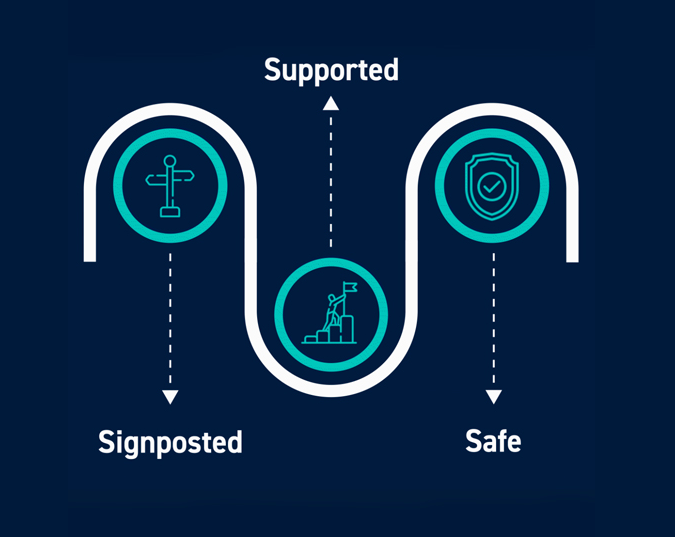83% of Irish workers would like to continue to work from home after the pandemic. This is according to a 2020 national survey carried out by the Western Development Commission in conjunction with NUI Galway. Since then, Ireland has unveiled its plans to legislate for increased worker rights and supports when it comes to working from home. Leo Varadkar stated in a recent article that ‘it would also require a cultural shift in favour of facilitating it as an option’. This indicates that home-working is not only here to stay but that the majority of employees who can avail of it, will take the opportunity to do so, beyond the pandemic.
 The methods for strategic design and delivery are changing within organisations. The task of setting and delivering a strategy is no longer a straight road. Today, it’s a grittier and more complex task that requires agility and an ability to adapt well to ever-changing external environments and conditions. Strategies that were agreed at a certain point in time can lose relevance as conditions change unexpectedly.
The methods for strategic design and delivery are changing within organisations. The task of setting and delivering a strategy is no longer a straight road. Today, it’s a grittier and more complex task that requires agility and an ability to adapt well to ever-changing external environments and conditions. Strategies that were agreed at a certain point in time can lose relevance as conditions change unexpectedly.
A good question for leaders to ask now is ‘What is our organisation’s process for refining plans? And, once refined, how do changes trickle down so that the strategy is delivered by staff on a day-to-day basis?
Here we discuss three key points to consider. These are aimed at creating and maintaining a strategy that is meaningful, adaptable and relatable to all employees within the organisation.
- Take a strategic approach to HR Management (i.e., SHRM)–
This allows the organisational strategy to become embedded throughout the organisation’s ‘DNA’. With a strategic approach to HR management, the organisational strategy drives the people-agenda. This translates into the behavioural and technical output, captured in the performance management systems used throughout the company.
- Huselid et al. (1997) defines SHRM as ‘all those activities affecting the behaviour of individuals in their efforts to formulate and implement the strategic needs of the business’ Schuler (1992 p. 30)
- The operational objectives and deliverables thus emerge from this process as a ‘living and breathing’ aspect of the way teams and individuals work together to achieve a desired outcome.
- The organisation who takes a strategic approach to HR Management will ‘see the people of the organisation as a ‘strategic resource’ for the achievement of ‘competitive advantage’. Hendry and Pettigrew (1986: 4)
Ultimately, to bring the organisational strategy to life, development of the people resource, as set out in the HR Strategy, must play a central role. Areas such as performance management systems and resources, formal and informal coaching and mentoring, recruitment and selection processes along with reward, recognition and exit processes must all form part of the people-agenda.
- Embrace Employee engagement methodologies – Engage, engage, engage! Check out the link here to our previous blog where we share tips on how to create sustainable employee engagement opportunities in your organisation: https://obrienlearningsolutions.ie/employee-engagement/easy-tips-to-re-engage-employees-during-covid-19/
- Laser focused performance management – Review, re-direct, and re-focus! And continue the cycle…
- Great performance management will have a Continuous improvement focus at the heart of the process “If you do not have a Continuous Improvement strategy, your future is at risk.” (Gerard Poolman, Shell)
- Ongoing coaching, feedback and mentoring provide the keys to success when it comes to the Performance review process for modern times
- A recent Harvard Business Review article suggests that peer feedback may form an integral part of the post pandemic performance review
- This again relies on a basic skill-set across all levels in understanding strategic goals and applying these to current working practices, identifying opportunities for seeking and providing feedback and learning how to apply basic continuous improvement methodologies to the day-to-day role
Watch how organisational strategy comes to life, when these measures are put in place, consistently and over a sustained period of time. Contact us today to discuss how this approach can be applied within your organisation.
Sources:
- :https://hbr.org/2021/01/are-peer-reviews-the-future-of-performance-evaluations
- https://www.wdc.ie/remote-working-in-ireland-during-covid-19-initial-findings-from-wdc-nuig-survey/
- https://www.irishtimes.com/news/ireland/irish-news/new-laws-will-give-employees-in-the-state-the-option-to-permanently-work-from-home-1.4458770

FREE RESOURCE - EVOLVE
COMPLETE OUR CULTURAL GAP ANALYSIS TOOL
Carry out an easy 3-step gap analysis now, which we will be happy to follow up with a free, no obligation virtual check-in.





